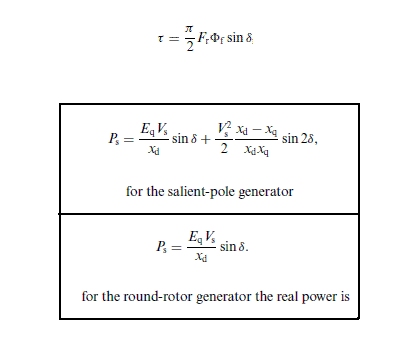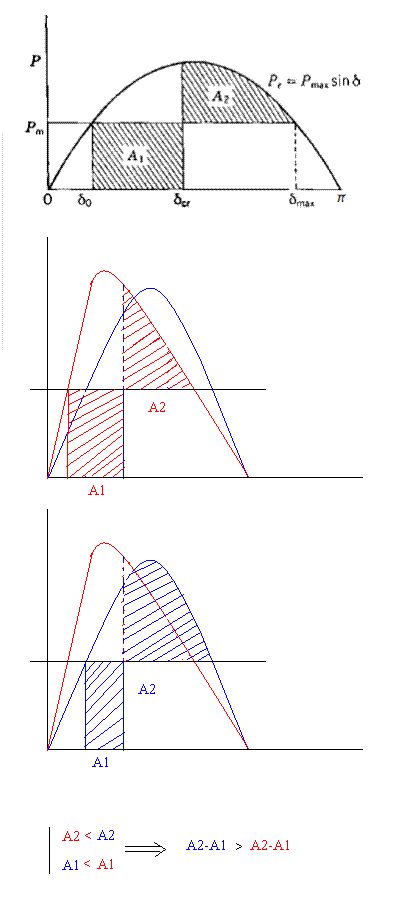- This topic has 1 reply, 1 voice, and was last updated 2 years, 11 months ago by .
-
Topic
-
Which type of machine is more stable, round rotor or salient pole?
Which type of machine is more stable, round rotor or salient pole?
Viewing 1 replies (of 1 total)
Viewing 1 replies (of 1 total)
- You must be logged in to reply to this topic.

 The second component, termed the reluctance torque, arises as the rotor tries to assume a position of minimum magnetic reluctance by moving towards the air-gap mmf. This additional torque is due to the non-uniform air gap and is a direct consequence of the air-gap mmf and flux not being in phase. The reluctance torque is present even without any field excitation and is proportional to sin 2?. It vanishes for both ? = 0 and ? = ?/2. As you know from single generator stability theory (equal – area criterion), The areas A1 (figure below) is directly proportional to the increase in kinetic energy of the rotor while it is accelerating, whereas areas A2 is proportional t o the decrease in kinetic energy of the rotor while it is decelerating. Therefore, the equal – area criterion states that the kinetic energy added to the rotor following a fault must be removed after the fault in order to restore the rotor to synchronous speed. The shaded area A1 is dependent on the time taken to clear the fault. If there is delay in clearing, the angle ?c is increased; likewise, the area A2 increases and the equal-area criterion requires that area A2 also increase to restore the rotor to synchronous speed at a larger angle of maximum swing ?x. Generally comparing between the round and salient-pole rotor power curve, we expect smaller area A2 in salient-pole and area A1 in round case resulting deformation of power curve to left side as illustrated below. Therefore it seems performance stability of round rotor is better in fault conditions.
The second component, termed the reluctance torque, arises as the rotor tries to assume a position of minimum magnetic reluctance by moving towards the air-gap mmf. This additional torque is due to the non-uniform air gap and is a direct consequence of the air-gap mmf and flux not being in phase. The reluctance torque is present even without any field excitation and is proportional to sin 2?. It vanishes for both ? = 0 and ? = ?/2. As you know from single generator stability theory (equal – area criterion), The areas A1 (figure below) is directly proportional to the increase in kinetic energy of the rotor while it is accelerating, whereas areas A2 is proportional t o the decrease in kinetic energy of the rotor while it is decelerating. Therefore, the equal – area criterion states that the kinetic energy added to the rotor following a fault must be removed after the fault in order to restore the rotor to synchronous speed. The shaded area A1 is dependent on the time taken to clear the fault. If there is delay in clearing, the angle ?c is increased; likewise, the area A2 increases and the equal-area criterion requires that area A2 also increase to restore the rotor to synchronous speed at a larger angle of maximum swing ?x. Generally comparing between the round and salient-pole rotor power curve, we expect smaller area A2 in salient-pole and area A1 in round case resulting deformation of power curve to left side as illustrated below. Therefore it seems performance stability of round rotor is better in fault conditions. 